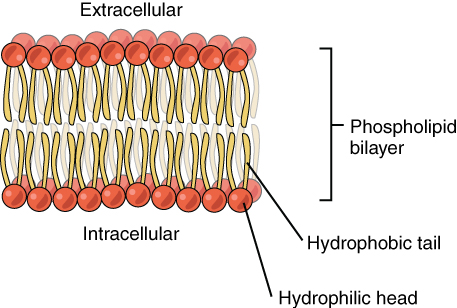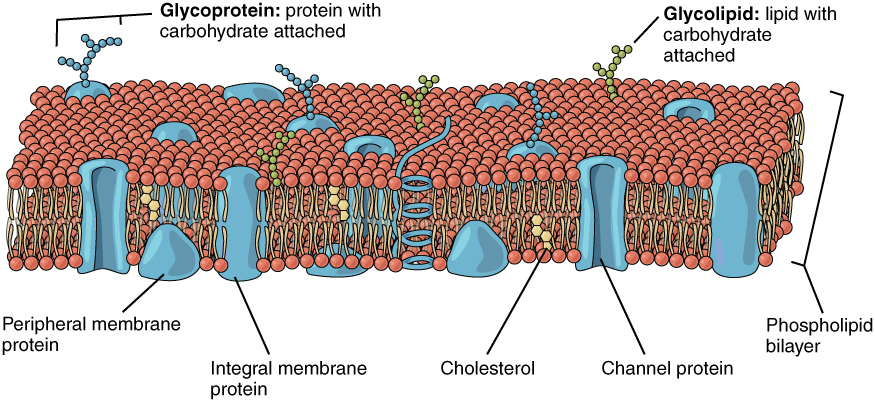Haseung Jun
Tejas Bhartiya
AP Biology 🧬
358 resourcesSee Units
Plasma Membranes
The plasma membrane is made up of a phospholipid bilayer. These have 2 parts, a hydrophobic (water-hating) part, and a hydrophilic (water-loving) part.
The hydrophilic heads, comprised of a phosphate group, face the outside and inside of the cell, where water is present. The hydrophobic tails, comprised of fatty acids, face inward and do not interact with water.

Image courtesy of Wikimedia Commons
As seen below, there are proteins embedded into the plasma membrane. These proteins can be hydrophobic, hydrophilic, charged, uncharged, polar, or non-polar depending on the configuration of the amino acids in the protein. So that means the hydrophilic part of the protein will be embedded in the hydrophilic part of the membrane while the hydrophobic part of the protein will hide inside with the tails.

Image courtesy of Wikimedia Commons
The cell membrane also has glycoproteins and glycolipids attached to it along with steroids. These groups help with cell signaling and the attachment of the cell to other structures.
Models of the plasma membrane are given the name: fluid mosaic model. This represents the fact that the membrane is fluid and somewhat moveable. The proteins embedded in the membrane, which serve a variety of functions, create the mosaic portion of the name.
These proteins come to play a vital role in almost everything. There are five broad categories for these transmembrane proteins.
- adhesion proteins - form junction between cells
- receptor proteins - receive messages such as hormones (act as docking site)
- transport proteins - pumps that actively transport stuff using ATP
- channel proteins - form channel that passively transport stuff
- cell surface markers - act as ID card for the cell
🎥 Watch AP Biology - Plasma Membranes
Membrane Permeability
Thanks to the structure of the membrane, with the hydrophobic tails and hydrophilic heads, the cellular membrane has selective permeability. This allows some substances to cross easily, while others may not be able to cross or may require a special transport protein to do so.
The membrane acts like a barrier separating the inside of the cell from the external environment of the cell.
Small, non-polar molecules are able to freely cross the cell membrane, while polar or charged molecules require transport proteins to cross. If a molecule is small, polar, and uncharged (like water!) it may be able to pass through the membrane in small quantities but requires a transport protein to move across in any larger quantities.
The hydrophobic fatty acid tails are what controls the movement of substances described above. They repel charged and polar molecules and make it very challenging for them to come across.

Image courtesy of Wikimedia Commons
Check out the AP Bio Unit 2 Replays or watch the 2021 Unit 2 Cram
Browse Study Guides By Unit
🧪Unit 1 – Chemistry of Life
🧬Unit 2 – Cell Structure & Function
🔋Unit 3 – Cellular Energetics
🦠Unit 4 – Cell Communication & Cell Cycle
👪Unit 5 – Heredity
👻Unit 6 – Gene Expression & Regulation
🦍Unit 7 – Natural Selection
🌲Unit 8 – Ecology
📚Study Tools
🧐Exam Skills

Fiveable
Resources
© 2025 Fiveable Inc. All rights reserved.